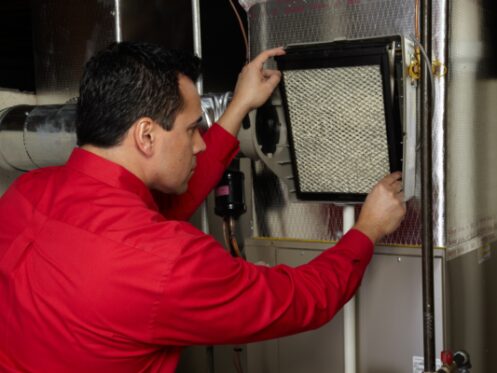Whether you’re purchasing a new property in the Denver, CO, area or you’re simply looking to confirm that your heating and cooling system is in good working order, professional assistance is important. Failing to schedule a routine inspection of your HVAC system can result in unexpected expenses or an inefficient unit. Not to mention, you could be left with an uncomfortable home due to an unexpected breakdown. As a homeowner, it’s beneficial to understand what an HVAC inspection is and what it includes.
What is an HVAC Inspection?
An HVAC inspection is an in-depth evaluation of all the property’s heating, cooling, and ventilation systems. The entire process is completed by a certified HVAC technician. They look at the age of the system, the cleanliness of individual components, how well everything functions, the condition of all of the system components, and the quality of safety features.
Why Is an HVAC Inspection Needed?
An HVAC inspection prevents property owners from encountering surprise expenses and the frustration associated with dealing with a broken, malfunctioning, or old HVAC system. This assessment identifies the condition and efficiency of different parts, providing property owners with the information necessary to decide if repairing or replacing HVAC components is in their best interest. It also reveals potential high utility bills and expensive repairs before the property owner settles into the new property.
When purchasing a new property, buyers commonly conduct a general inspection that examines the building structure, roof, foundation, electrical work, and plumbing. This should also include an overview of all HVAC equipment. During this general assessment, the inspector might only check whether the unit turns off or on. However, this differs from having an HVAC technician perform a thorough test that utilizes their years of experience to check things such as:
Thermostat
Ensuring the thermostat operates correctly is crucial. The technician will test the device, review internal wiring, and confirm proper functionality. Activating the furnace is one thing, but it’s essential to ensure the thermostat reaches its set temperature, avoiding short cycles and addressing any internal issues that could lead to increased utility bills or damage.
Furnace Cabinet
The technician examines the structure and condition of the furnace cabinet, checking for damage, rust, and loose parts. This component is vital as it houses the internal furnace elements.
Furnace Electrical Components
While inspecting the furnace cabinet, the HVAC technician examines electrical connections and tests safety features. This includes the limit switch, which shuts down the furnace in case of overheating issues.
Furnace Blower Wheel
The blower wheel propels air through the HVAC system, allowing the air to be heated and redistributed. A dirty, inefficient, or damaged blower wheel can lead to increased utility bills as the HVAC system works harder to meet household demands.
Furnace Ignition
Evaluation of the cleanliness and functionality of the ignition system, including flame sensors, burners, and igniters, is essential. Regular maintenance is key to preventing major heating repairs and ensuring consistent heating.
The Heat Exchanger and Exhaust Venting
An HVAC technician will inspect the flue pipe, checking for holes or cracks that could pose a risk to occupants. Holes and cracks in the heat exchanger may lead to carbon monoxide leaks, which can be deadly. Only qualified HVAC professionals should perform this aspect of the inspection.
Carbon Monoxide and Gas Test
Safety checks during an HVAC evaluation help identify gas or carbon monoxide leaks. Carbon monoxide poisoning is fatal, and gas leaks can lead to fires or explosions. The technician can also ensure the proper functioning of the installed carbon monoxide detectors.
Air Conditioning System Inspection
An HVAC technician will inspect the air conditioning unit that is part of your HVAC system, examining the evaporator coil, condenser coil, and blower fans to ensure proper functionality. The presence of dirt, freezing, mold, or mildew in any aspect of your air conditioner can lead to a system malfunction.
Drain Pan
It’s possible for mold to build up in an air conditioning system’s drain pan. During the inspection, your technician will look at the drain pan, ensuring that water is not leaking into your home.
Condensate Line
Examining the condensate line is key to preventing water leaks. During the inspection, the technician will see if the line has loose connections, if it is cracked, or if it has holes. They will also look at the condensate trap, pump, and drain to ensure they are not clogged.
Outside Condenser and Blower Fan
It’s important to assess the condition of the air conditioner’s condenser unit. An evaluation of the efficiency of the condenser fan and motor ensures they are undamaged and operating within the parameters set by the unit’s manufacturer.
Refrigerant Levels
The next step is looking at the air conditioner’s refrigerant level. Problems with the air conditioner, such as not cooling properly or freezing up, often result from a refrigerant leak. Refueling refrigerant is not a do-it-yourself job. Most homeowners or commercial property owners do not have the equipment needed to do this job safely. It’s important to know the proper refrigerant to use and to avoid refrigerants that are banned.
Electrical Components
The HVAC specialist will inspect all electrical connections and wiring. They will assess efficiency, measure voltage and amp draws, and ensure that there are no problems that could potentially lead to air conditioning emergencies or fires. They will look at the motor capacitor, ensuring it works properly. Any problem electrically with the air conditioner could cause it to make unusual sounds, shut off completely, or not turn on at all.
Ventilation Inspection
During an HVAC inspection, proper airflow will be assessed. This involves performing inspections on the external condition of the unit, testing the air temperature in the duct system, and evaluating static pressure to guarantee adequate airflow.
Without proper airflow, you might spend a lot of money on energy bills without getting the comfort you desire. Airflow issues could result from leaking air ducts, improperly sized ducts, or a flow restriction.
During this inspection, an HVAC professional examines your ductwork for damage, evaluates the furnace filter to determine if it should be replaced, and checks registers, grills, and vents to ensure proper functionality. Air quality recommendations may be made during this inspection, such as installing a dehumidifier or air purifier or making other adjustments like purchasing a new HVAC unit.
Working With Denver’s Most Trusted Heating and Air Conditioning Company
At Summit Heating, A/C, Plumbing & Electrical, we work diligently to ensure that our customers’ comfort needs are met. We want your family to be able to enjoy your home comfortably and safely. We have provided HVAC services to customers in the Denver area since 1998. We have NATE-certified technicians who are extremely experienced in their field.
Our services include HVAC installation, maintenance, and repair. We offer emergency furnace repair and install and repair heat pumps and mini-splits. Our plumbing services include water heater repair, installation, and tankless water heaters. We schedule routine and emergency drain cleanings, pipe repair, and sewer repair or replacement. We also offer general electrical services. Contact Summit Heating, A/C, Plumbing & Electrical today for reliable heating and cooling assistance.


